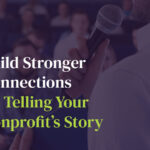Donor Prospect Research: 4 Frequently Asked Questions

There are thousands of ways to fundraise for your nonprofit, from online campaigns to events and membership programs. But one of the most important forms of fundraising is seeking out major gifts.
Whether your organization is new to the nonprofit scene or you’ve been fundraising for decades, you know the importance of securing major gifts for your cause. These are the largest gifts your organization receives, and they empower you to truly move the needle on your mission.
But before you can consistently secure major gifts for your nonprofit, you have to first identify the donors who are willing and able to give large gifts to your organization. This is done through the donor prospect research process.
Donor prospect research, also known as prospect research or prospecting, involves examining data about individuals outside of your current donor pool in order to learn more about their potential interest in your cause, their philanthropic history, and what they might be able to give. It’s a complex process that you need to get right if you want to build lasting relationships with major donors and secure impactful gifts for your cause.
In this guide, we’ll help you get started with prospecting (or help you brush up on the specifics!) by answering four frequently asked questions. Let’s dive in.
1. Why should my nonprofit conduct donor prospect research?
As mentioned above, donor prospect research enables you to identify viable major donor prospects for your nonprofit. Specific major gift amounts will depend on the size of your organization. For example, for one organization, $10,000 may be considered the minimum major gift amount. For another organization, the major gift threshold may start at $50,000.
Although these specifics will be unique to your organization, the benefits of conducting prospect research in order to find major donors are quite universal. According to Donorly’s guide to finding major donors, these benefits include:
- Securing a significant portion of your nonprofit’s overall revenue. Have you heard of the 80/20 rule? It states that 80 percent of your nonprofit’s revenue comes from just 20% of your donors. While all donors and donations are important for your nonprofit to progress, you should put special time and effort into identifying and building relationships with major donors for this reason.
- Getting a strong start with large-scale projects like capital campaigns. Whether you’re looking to renovate your facility, build up an endowment, or purchase new equipment, a capital campaign is a huge endeavor that requires a foundation of major gifts to be successful. In fact, most of the time that goes into a capital campaign will involve soliciting major donations.
- Enlisting your major donors as enthusiastic ambassadors for your organization. Major donors don’t just give large gifts—they also have large hearts and care deeply about your cause. Because of this, they can play a large part in driving awareness for and involvement with your organization.
Prospect research gives your nonprofit the information it needs to cultivate strong relationships with major donors, so it’s a process worth getting right regardless of your current relationship with major donor fundraising.
2. What is the difference between prospect research and wealth screening?
As you learn more about prospect research, you’ll likely see the term “wealth screening” (or just “screening”) pop up. However, wealth screening is just part of a comprehensive prospect research process. Let’s look at the process in a little more detail.
Donor prospect research involves examining three different types of indicators or markers:
- Propensity Indicators: Also known as habit indicators, propensity markers show that an individual has a habit of philanthropic giving. These indicators include:
- Being on the donor list for other organizations
- Board service for other organizations
- Fundraising event attendance
- Affinity Indicators: Also known as warmth indicators, affinity markers show that an individual may have a personal interest in supporting your specific mission because it resonates with them on a personal level. These indicators include:
- Political affiliations
- Past involvement and donation history with your organization or similar organizations
- Personal or professional connections with your current donors
- Personal alignment with your mission
- Capacity Indicators: Capacity indicators, also known as wealth markers, show that an individual is in a financial position to give a large gift. These indicators include:
- Real estate ownership
- Political giving history
- Stock holdings
- Business ownership or connections
As you prospect, if you find individuals that exhibit all three types of indicators, you can be confident that you’ve found a viable prospect to begin building a relationship with. Note that you won’t be conducting cold outreach—you’ll likely have some existing connection to the prospect, whether they’ve given to your organization in the past or they’re friends with one of your board members who can make an introduction for you.
Wealth screening involves examining capacity indicators alone. Typically, you’ll use this process to screen individuals that are already in your donor pool. These individuals’ affinity and propensity can be inferred, but they may not have been invited yet to level up their giving.
3. How do you conduct prospect research?
In order to find individuals who exhibit propensity, affinity, and capacity markers, you’ll need to comb through and organize a lot of data. To do so, you can rely on tools such as:
- Your nonprofit’s CRM
- Google and Wikipedia
- Internet archive tools
- Government records like SEC investment records and FEC political contribution information
- Matching gift database
- Social media platforms
- Prospect generator tools and databases
As you collect and interpret data, remember to store what you learn about each individual prospect in a prospect profile. This way, you’ll have all the information you need to begin building a relationship with each individual. Plus, you can add to the profile throughout the stewardship process.
Of course, your team can manage its prospect research efforts on its own. But you may quickly find that you’re buried in data and don’t have the time or know-how for uncovering actionable insights on top of all the work you do on a regular basis.
That’s where the help of a consultant comes in. According to Donorly, you can hand over the donor research process to a nonprofit consultant to get more out of the process and to save your team time and resources. Plus, the right consultant will be a true partner for your organization and help you not only find major donors but guide you through an effective approach to cultivating them.
4. How can I put prospect research insights into action?
Once you’ve conducted prospect research and found some individuals that you want to start building donor relationships with, you’ve only just started the process of major donor fundraising. Next comes the task of putting your prospect research insights into action.
Here are a few ideas for doing so:
- Ask for introductions. New prospects will likely be connected to someone who is already involved with your organization, whether they have a professional connection to a board member or their parent is a dedicated donor. Ask the person they’re connected with to make an introduction for you. This is a natural way to kickstart a conversation about your cause and also gives the prospect someone to talk to to learn more about your organization and what it is like to be a part of it.
- Connect often. After your initial conversation, keep in touch with your prospect. Make sure to adhere to their communication preferences so that you know how they like to be contacted. For example, one donor may prefer an email or a conversation over coffee, while another may like receiving calls from your organization. As you continue to connect, get to know the prospect as a person and keep them updated on what your organization is doing.
- Invite involvement. Giving a gift isn’t the only way for your prospect to have meaningful experiences with your nonprofit. In fact, other forms of involvement will only help to deepen their connection to your cause. Reach out when an opportunity arises that you think they’d be interested in. For example, they might enjoy volunteering for your weekend river clean up one month, or they might be excited to attend your upcoming golf tournament.
It will likely take a few weeks or months, but as you follow these steps, you’ll find that your donor prospects get more and more invested in your nonprofit’s work and that they’ll soon be receptive to a donation request. As you get to know them, make sure you’re preparing an initial ask that will be personally meaningful and will also help your nonprofit make progress with its mission.
Major donor fundraising is made possible by thorough prospect research, but the process involves a lot of complexity. As you review these frequently asked questions, remember that a nonprofit consultant who is an expert in prospecting can be a great resource to turn to for more help.


